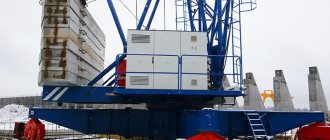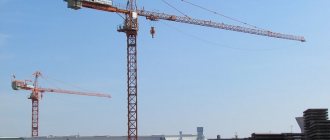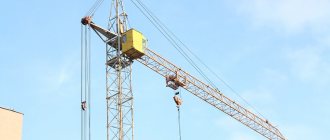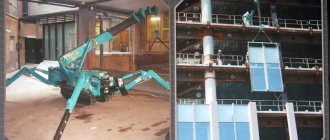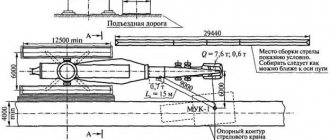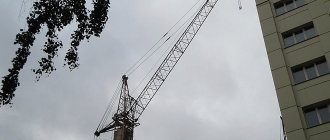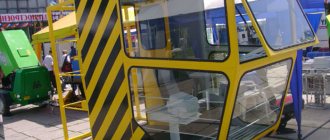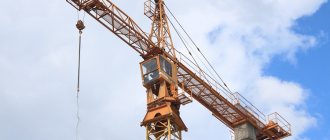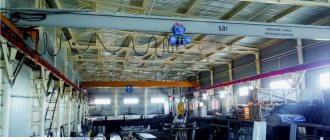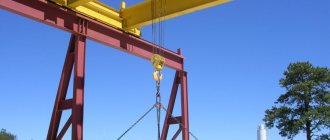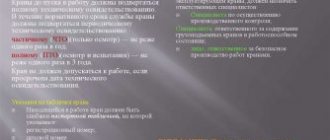Installation of tower cranes
Didn't find your city on the list?
Call +. We are always ready for mutually beneficial cooperation! We provide services in the following cities
| Arkhangelsk | Volgograd | Kislovodsk | Nizhny Novgorod | Ryazan | Tolyatti |
| Astrakhan | Vologda | Krasnodar | Eagle | Samara | Tula |
| Belgorod | Voronezh | Kursk | Orenburg | Saint Petersburg | Ulyanovsk |
| Blagoveshchensk | Ivanovo | Lipetsk | Penza | Saratov | Ufa |
| Bryansk | Kazan | Magnitogorsk | Pskov | Smolensk | Cheboksary |
| Velikiy Novgorod | Kaluga | Moscow | Pyatigorsk | Stavropol | Chelyabinsk |
| Vladimir | Kirov | Murmansk | Rostov-on-Don | Tver | Yaroslavl |
A tower crane is the optimal solution to the problem of delivering building materials to significant heights. It is this fact that explains their demand for the construction of buildings for various purposes (industrial, residential, industrial).
Installation of a tower crane requires high-altitude work and the use of additional equipment. The assembly of lifting equipment of this type is a priority activity of TekhKranMontazh.
Our company’s specialists have been certified, have the appropriate permits and will professionally carry out installation work on crane equipment in a short time.
"TechKranMontazh" offers installation of tower cranes of various models:
- Tower crane of domestic production: KB 401; KB 403; KB 405; KB 408; KB 473; KB 474; KB 503; KB 504; KB 515; KB 674; KB 676.
- Installation of imported tower cranes: POTAIN; Liebherr; Terex, YANGMAO; SOIMA; Linden Comansa.
Types, features, installation stages
Installation technologies are different, their choice depends on the construction site (size), design features of the crane, its location and other factors.
At the initial stage, in accordance with RD11-06 and the FNP “Safety Rules for Hazardous Industrial Facilities that Use Lifting Structures,” a PPRk (installation project) is developed. It indicates all the main points related to the installation of equipment at a given construction site.
Drawing up design documentation allows us to ensure the safety of installation work and further operation of lifting equipment. Subsequent activities for assembling the tower crane are carried out in accordance with the PPRk:
The above activities are preparatory in nature and are mandatory before starting the assembly of the tower crane.
Installing tower cranes using a telescope
This type of installation received its name due to the use of a special feed/extension of sections (they are extended according to the principle of a telescope). Its difference is in the use of a retractable frame fixed to the outside of the column (tower). Installation steps:
- The support frame and running trolleys are installed.
- A counterweight (lower) is mounted.
- The outer sections of the tower are assembled to the design height.
- At the end of the uppermost section, an intermediate frame is installed, onto which a retractable clip is attached.
- The required number of internal sections (they have a smaller cross-section) are inserted into the outer sections of the tower.
- The boom and counterweight console are attached to the head.
The retractable cage is equipped with a special mechanism that allows the inner sections to be pulled out from the outer tower. Thus, you can quickly “grow” the column to the required height. In this case, the boom and counterweight console will already be installed on the crane.
Installation using a truck crane
The principle of installation work is based on the sequential assembly of crane structures, starting from the support frame and ending with the boom. Sections and elements of the lifting mechanism are delivered to a height using a truck crane (in each case, the lifting capacity and boom height of the machine are selected individually). Docking and fastening of tower crane segments is carried out by high-rise assemblers.
Installation of fasteners for tower cranes
carries out installation of support fasteners for tower cranes. These works are necessary when extending a tower crane to a height of more than 40 m, which ensures a stable position.
Tower crane fasteners come in round and rectangular sections. Installation of fasteners for tower cranes is carried out only during PPRk.
Self-erecting cranes
Installation of self-erecting tower cranes is quick and requires minimal time. This category includes equipment from POTAIN, Terex, etc. Depending on the model, installation of a tower crane by our specialists will take from 30 minutes to several hours.
Upon completion of the complex of installation works, TekhKranMontazh will carry out tests (static/dynamic) and commissioning of lifting equipment.
Do you want to leave a request? Call tel. or fill out the form below
.
Source: https://remcran.ru/services/montazh-bashennykh-kranov/
Manufacturing of fasteners for tower cranes – Fire-Steel
In modern construction, when constructing high-rise buildings, various special equipment, including tower cranes, are used to carry out the work.
To ensure safe and efficient operation of the crane, secure fastening is essential.
As the height of the object under construction increases, the need arises for strong fastening of lifting equipment using tower fasteners. These structures are the main auxiliary devices that guarantee safety when lifting loads.
The need to use fasteners
The crane fastener provides fastening of the tower crane to the building to eliminate swinging of special equipment during operation and prevent emergency situations, for example, under wind loads or when lifting heavy loads to a height exceeding 40-50 meters.
A tower fastener is a system consisting of several rods and supports connected into a rigid metal structure.
Types of faucet fasteners
There are different types of fasteners: box-shaped, traction, round, rectangular. For their production, profile metal products are used: pipes, channels, angles. When the fastener is installed on one side, it is attached to the crane mast below the slewing ring. Hinges are used as fastening elements. On the other hand, the fastener is attached to interfloor spacers, columns or floors to embedded parts using welding, brackets or studs.
manufactures high-quality metal fasteners for tower cranes, taking into account the characteristics of the object being built and the individual wishes of the customer. When choosing materials for the production of traction systems, frames, connections, we take into account the operating conditions. Work on the design and production of fasteners is carried out in strict compliance with the requirements of GOST, sanitary, industrial and technical safety.
The most popular and practical are beam supports:
- rectangular section (channel, corner);
- round section (W from 219 mm).
Features of tower mounts
The use of support fastening is necessary when building a tower crane above its position, regulated by the data in the passport for this model of special equipment. The number of fasteners and their installation marks are calculated during the project development process.
The crane support, consisting of horizontal supports, is installed at one or more levels. The design of the horizontal support includes several separate rods (links), which are attached at the ends to the crane tower and the object being built.
There are two types of rods, the material and length of which depend on the distance from the installation site of the crane to the building being constructed. To make connections up to 10 meters long, pipes with a diameter of d=219 mm and d=273 mm are used. If it is necessary to produce larger rods, then the material used is an angle profile, channels and plates.
As a rule, technological columns are used to attach the fasteners to the object, which are installed between the floors of the building. If it is not possible to use this option, the ties are attached to the columns of the building or to one floor using “shoes”.
Calculation of crane fasteners
Fastenings are manufactured according to an individual project, which may include covering frames for the crane. Often, if you have a standard project, you have to adjust it to link it to a specific object based on the input data.
Even when there is a standard project, it needs to be changed (linked) to the object under construction, taking into account the input data. Calculation of crane fastenings is carried out in strict compliance with the requirements regulated by RD-22-38-2007 and taking into account:
- tower crane type;
- tower heights;
- the magnitude of the load on the vertical support and fastening in working/non-working condition;
- data from the PPR project related to the installation of the crane;
- design features of tower elements;
- parameters of horizontal attachment to the building and its type: box-shaped, tubular or rectangular;
- lengths of connecting elements;
- characteristics of the strength and range of materials included in the “connection” of components: angles, channels, fasteners, welds and connecting assemblies.
In our company, the development and production of tower fasteners is carried out by certified specialists who strictly comply with the norms and requirements of industrial and technical safety for crane structures and building structures.
The customer receives a full package of documentation with a passport for support fastenings based on the results of acceptance.
Why us
Our company has extensive experience in the production of metal structures for various purposes. We guarantee high quality products, strict adherence to deadlines, and offer the best prices from the manufacturer in Moscow and the Moscow region.
Source: https://fire-steel.ru/pristezhki-dlya-bashennyx-kranov/
Our developments Support mounts for tower cranesIn modern high-rise construction, attached tower cranes of domestic and foreign production are widely used. The height of an overhead tower crane increases in stages as the height of the building increases. At each stage, the crane is attached to the building and extended to a certain height. The number of fastenings is determined at the design stage of the work and depends on the design of the crane, the height of the building and the presence of other tower cranes at the site.
The crane is attached to the building using ties (rods), which are welded metal structures of adjustable length. The structures are connected on one side to a crane, and on the other to a supporting element that transfers the load directly to the load-bearing elements of the building. The length of the rods can be adjusted in the range necessary to compensate for inaccuracies in the installation of the crane, supporting elements and manufacturing of fastening units.
All fastening elements are calculated for the loads transmitted from the crane to the building. The location and method of fastening must be agreed upon with the author of the building design.
The project for fastening tower cranes is developed taking into account many factors: the position of the crane at the site (project for the work to be carried out with cranes), technical characteristics of the crane (passport and instructions for installing the crane), design features of the building being constructed, etc.
Examples of crane fastening
Depending on the distance of the crane from the building and, accordingly, the length of the fastenings, they are made from pipes or a box section from a channel or angles. In practice, the length of the links in some cases reaches 26 meters.
The production of these components is carried out by highly qualified specialists who have permission from Rostekhnadzor, with whom we maintain close ties.
The crane is fastened directly to the building using racks, which are attached to the ceilings either through embedded parts by welding, or using studs, as well as brackets.
It is also possible to directly pour the racks into the ceiling, which allows you to save up to 1 ton of metal at each level of fastenings.
In domestic cranes, such as KB-473, KB-573, KB-674 and some foreign-made cranes, in which the installation locations for height connections are strictly regulated, situations may arise when the fastening levels fall into the ceilings.
There are other, even more complex, mounting options. Such structures are characterized by increased metal consumption and difficult installation.
To avoid such difficulties, we provide free consultations at the stage of development of the PPRk. Often, from the point of view of the work project, it does not present any difficulties to move a crane, rotate a tower or deepen the base of a crane. However, such simple measures can significantly facilitate the work of fastening a tower crane and reduce its cost.
When developing a project, we select the optimal location of fastening rods, which leads to a reduction in loads, weight and, ultimately, the cost of fastening. We also try to place fastening elements in existing openings, which facilitates both fastening installation and further construction.
Mounting lifts
All lifts are equipped with a set of inventory fasteners that allow them to be securely fastened to the building. Additional fastenings are used in cases where the inventory fastenings are not enough.
For example, if a building has a complex floor configuration, or floors of different configurations, the length of the inventory fastening may not be enough. In this case, an additional fastening is used to lengthen the inventory. Also, in such situations, transition platforms for people to exit are often required.
Sometimes the inventory mount may not fit the height of the (under) ceiling, or must go through the window opening. In these cases, additional fastening serves to connect the inventory fastening to the ceilings or walls of the building.
Finally, additional bracing may be required if the bracing load needs to be distributed across multiple building structural members.
Mounted and remote load-receiving platforms
Canopy platforms
are intended for finishing, facing works, as well as other construction and installation works on the facades of monolithic and prefabricated buildings. Various installation options are available:
- - on the floor with fastening with inventory racks from the formwork;
- - on the ceiling with fastening with studs through the ceiling (installation is mainly on the top floor.)
- - through a window or into holes left in advance in the wall (~ 200x250 mm) and secured with a thrust beam.
The loading capacity of the platforms is 250 - 2000 kg.
Remote load-receiving platforms
designed for receiving cargo on the floors of buildings under construction and reconstruction, as well as for construction and installation work. Loads are supplied to the sites using cranes (tower and truck). Various fastening options are provided:
- — inventory formwork racks with emphasis on the ceiling;
- - with studs behind the ceiling or behind the walls
Loading capacity of platforms – Q = 1000 – 2500 kg.
Sites for assembly
works are intended for installation work on areas of blank walls of a building. Various mounting options are available:
- - for loops pre-embedded in the outer wall;
- - with studs behind the outer wall (options for installing studs in the holes remaining from the fastening of the formwork are possible).
Loading capacity of platforms – Q = 500 – 200 kg.
We have developed a wide range of ready-made projects for mounted and remote platforms used for construction and installation works (CEM). We also develop projects for finished products, but in this case, modifications to the product are possible to bring it into compliance with safety standards.
Self-balancing traverse
The self-balancing traverse is designed for installation of permanent formwork. The traverse consists of a metal structure, a rope suspension for hanging on a crane hook and 8 chain slings for hanging permanent formwork from the traverse.
Crane mounts
All tower cranes at high heights need to be secured to the building being constructed. Depending on the model of the construction crane, the fastenings (crane fasteners) are located at different marks . There is a trend across different crane manufacturers - the first mount is mounted at a height of approximately 35 - 40 m.
When installing a crane mount, the load on the foundation is significantly reduced .
Combination crane mount (1)
Initial data
The following are usually required as input data for project development:
- Crane work project (PPRk);
- Passport data for the crane with a table of loads (lateral force and torque) for the operating state of the crane and for non-operating;
- Design of load-bearing structures of the building (sections KR or KZH).
Project composition
In general, the working documentation developed for fastening a tower crane includes the following:
- Product passport required for the operation of the fastening, its conservation and commissioning ;
- A structural steel design that includes assembly drawings , detail drawings , and specifications of materials needed to manufacture the product.
Below are selected sheets from a typical tower crane fastening project:
Faucet mounting location drawing (1) Fastener assembly drawing (2) Fastening installation drawing (3)
Calculation of crane mounting
Crane fastening is calculated in two main stages:
1. Determination of current loads . As part of the initial data, the Customer transfers passport data - loads from the crane tower at the installation site of the fastener. The calculation of the load on the fastener is carried out in the form of solving a system of equations, for the solution of which the angles of installation of the fasteners and the angle of rotation of the load from the crane are also taken into account - every 5 degrees.
2. Calculation of the strength of the fastening structure using the finite element method (FEM) in specialized software. The calculation is carried out on the basis of the designed 3D model of the fastener.
Universal crane mount
Our specialists have developed a design for a universal set of crane fastenings, consisting of prefabricated parts, having increased rigidity combined with low weight and high load-bearing capacity:
Crane fastener 3D
Fastenings are necessary to hold the crane tower in a vertical position, while in addition reducing the load on the foundation slab under the crane (in particular horizontal load and torque).
The load transmitted to the crane mount consists mainly of a horizontal component with an uncertain direction and a torque. Because of this uncertainty in the direction of the load, before designing the fastener, it is necessary to carry out calculations of the equation system to determine the forces in various directions of load application.
When calculating the fastening, it is necessary to take into account the largest loads:
- operating condition of the crane (horizontal force of variable direction and torque along the axis of the tower);
- non-operating condition of the crane (maximum horizontal force with usually no torque).
Calculation of a crane fastener comes down to solving a system of equations for different angles of application of horizontal force at the level of fastening installation.
Tower crane attachment rod - 1 Tower crane attachment rod - 2
Crane fastenings are three rod elements with hinged fastening at the edges, installed at different angles, ensuring spatial rigidity.
Basically, fasteners are made from pipes with a diameter of up to 326 mm . In rare cases, when the distance from the crane tower to the building under construction exceeds 8 m, fastenings from spatial trusses (four corners connected by plates) are used. All crane fastenings are equipped with adjustable screw inserts necessary for selecting gaps and enabling all structures to work.
Screw adjustment of fastening length
The cost of developing crane fastenings usually depends on the length of the fastenings (according to their configuration) and the method of installing the fastenings on the building structure. You can see the estimated costs for developing crane fasteners here .
How to get a project
Send us an application by email and attach a plan and section according to the PPRK - we will respond to you as soon as possible - we will tell you what the cost of the project will be, how long it will take to develop it, as well as the approximate type of the structure.
Source: https://pro-proectirovanie.ru/glavnaya-stranitsa/proekty-proizvodstva-rabot/konstrukcii/krepleniya-kranov/
| RљРѕРјР°РЅРґР° профессиональных монтажнико⠫КранКомпал ЅРё» осуществляет демонтаж/монтаж Р ±Р°С€РµРЅРЅС‹С… кранов SAEZ, FMGru, Liebherr, Potain, РљР' Рё любых РґСЂСѓРіРє… марок. |
COST AND DEVELOPMENT TIMES
Dear Customers, ICC PPR adheres to the average market pricing policy for the development of organizational, technological and working documentation. The average market cost of a project for attaching a tower crane to a building is assumed to be 35,000 rubles.
The development time for a tower crane fastening project is 5 working days.
The final cost and timing of the project development are determined at the stage of concluding the contract, taking into account the joint interests and wishes of both parties.
ICC PPR LLC also offers services for the manufacture and installation of fastenings for tower cranes to the building. The cost of 1t of metal fastening structures is 65,000 rubles.
